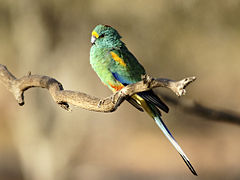Psephotellus
| Psephotellus | |||
| Mathews, 1913[1] | |||
 Przedstawiciel rodzaju – świergotka wielobarwna (P. varius) | |||
| Systematyka | |||
| Domena | |||
|---|---|---|---|
| Królestwo | |||
| Typ | |||
| Gromada | |||
| Podgromada | |||
| Infragromada | |||
| Rząd | |||
| Rodzina | |||
| Podrodzina | |||
| Plemię | |||
| Rodzaj | Psephotellus | ||
| Typ nomenklatoryczny | |||
Platycercus pulcherrimus Gould, 1845 | |||
| Synonimy | |||
| |||
| Gatunki | |||
| |||
Psephotellus – rodzaj ptaka z podrodziny dam (Loriinae) w rodzinie papug wschodnich (Psittaculidae).
Zasięg występowania
Rodzaj obejmuje gatunki występujące w Australii[3].
Morfologia
Długość ciała 26–28 cm; masa ciała 50–70 g[3].
Systematyka
Etymologia
- Psephotellus: rodzaj Psephotus Gould, 1845 (świergotka); łac. przyrostek zdrabniający -ellus[4].
- Clarkona: Austin Hobart Clark (1880–1954) – amerykański biolog morski, ornitolog, entomolog, kolekcjoner, ewolucjonista; łac. przyrostek -ona „odnoszący się do”[5]. Gatunek typowy: Psephotus varius A.H. Clark, 1910.
Podział systematyczny
Do rodzaju należą następujące gatunki[6]:
- Psephotellus varius (A.H. Clark, 1910) – świergotka wielobarwna
- Psephotellus dissimilis (Collett, 1898) – świergotka czarnogłowa
- Psephotellus chrysoptergius (Gould, 1858) – świergotka złotoskrzydła
- Psephotellus pulcherrimus (Gould, 1845) – świergotka rajska – takson wymarły, ostatnią potwierdzoną obserwację zanotowano w 1928 roku[7]
Przypisy
- ↑ G.M. Mathews. New generic names, with some notes on others. „Austral Avian Record”. 2, s. 57, 1913. (ang.).
- ↑ G.M. Mathews: The birds of Australia. Cz. 6. London: H.F. & G. Witherby, 1916–1917, s. 391. (ang.).
- ↑ a b S.M. Billerman: Old World Parrots (Psittaculidae), version 1.0. W: S.M. Billerman, B.K. Keeney, P.G. Rodewald & T.S. Schulenberg (red.): Birds of the World. Ithaca, NY: Cornell Lab of Ornithology, 2020. DOI: 10.2173/bow.psitta4.01. [dostęp 2020-10-22]. (ang.).

- ↑ Psephotellus, [w:] The Key to Scientific Names, J.A. Jobling (red.), [w:] Birds of the World, S.M. Billerman et al. (red.), Cornell Lab of Ornithology, Ithaca [dostęp 2022-01-30] (ang.).
- ↑ Clarkona, [w:] The Key to Scientific Names, J.A. Jobling (red.), [w:] Birds of the World, S.M. Billerman et al. (red.), Cornell Lab of Ornithology, Ithaca [dostęp 2022-01-30] (ang.).
- ↑ Systematyka i nazwy polskie za: P. Mielczarek, M. Kuziemko: Plemię: Platycercini Selby, 1836 (Wersja: 2020-11-16). [w:] Kompletna lista ptaków świata [on-line]. Instytut Nauk o Środowisku Uniwersytetu Jagiellońskiego. [dostęp 2021-07-26].
- ↑ BirdLife International, Psephotellus pulcherrimus, [w:] The IUCN Red List of Threatened Species 2020 [online], wersja 2020-2 [dostęp 2020-10-22] (ang.).
Media użyte na tej stronie
Autor: Jakob Voß, influenced by original art designed at PLoS, modified by Wikipedia users Nina and Beao, Licencja: CC0
Closed Access logo, derived from PLoS Open Access logo. Alternative version.
Autor: David Cook Wildlife Photography from Wamboin, NSW, Australia, Licencja: CC BY 2.0
A male Mulga Parrot at Gluepot Reserve, South Australia, Australia. Male. This species has benefited from the elevated watering points that Birds Australia has installed at Gluepot, each with a bird hide next to it. Large flocks of Mulga Parrots arrive at dawn to drink, 70 in a flock seen by the photographer one morning.

